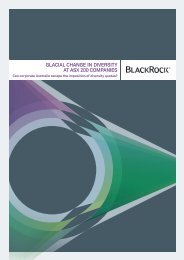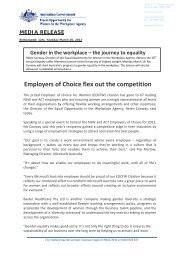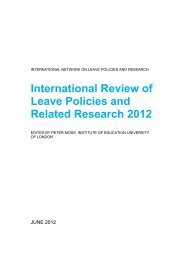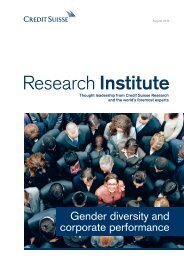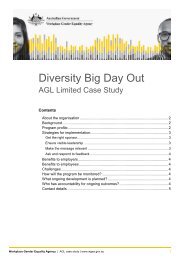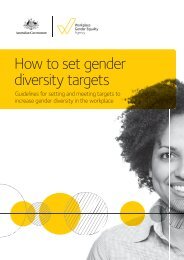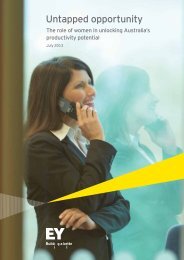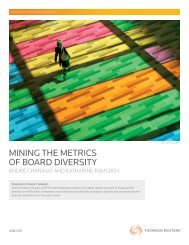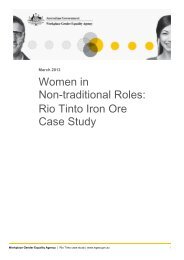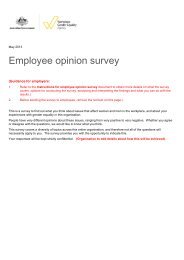Women in NSW 2012 - The Workplace Gender Equality Agency
Women in NSW 2012 - The Workplace Gender Equality Agency
Women in NSW 2012 - The Workplace Gender Equality Agency
Create successful ePaper yourself
Turn your PDF publications into a flip-book with our unique Google optimized e-Paper software.
Leadership andrepresentationThis chapter exam<strong>in</strong>es women’srepresentation <strong>in</strong> leadership roles <strong>in</strong>parliament, with<strong>in</strong> the public service,<strong>in</strong> the corporate sector, and with<strong>in</strong>certa<strong>in</strong> professions.Earlier chapters reveal that <strong>NSW</strong>women now make up 45 percentof the workforce and a majority ofhigher education students. <strong>Women</strong>live longer than men and aremore likely to undertake volunteerwork. Given their presence andachievements <strong>in</strong> many spheres ofcommunity life, women’s relativeabsence <strong>in</strong> the senior ranks of keysocial <strong>in</strong>stitutions is notable.<strong>The</strong> evidence presented belowsuggests that leadership genderequality has <strong>in</strong>creased <strong>in</strong> recentdecades. But there are areas whereprogress has been slow, veryrecent, or has stalled altogether.<strong>The</strong> <strong>NSW</strong> economy and key<strong>in</strong>stitutions are more likely to performoptimally if leadership is meritoriousand diverse. This chapter’s focustopic on chief executives highlightsrelationships (those between be<strong>in</strong>ga senior manager, marry<strong>in</strong>g andhav<strong>in</strong>g children) that shed some lighton questions about the compositionof leadership and which furtherresearch could explore <strong>in</strong> more detail.<strong>The</strong>re will be many views aboutthe underly<strong>in</strong>g causes of women’sunder-representation <strong>in</strong> leadershiproles; the data presented <strong>in</strong> thischapter is a contribution to thedebate on this important issue.Keyf<strong>in</strong>d<strong>in</strong>gsIn certa<strong>in</strong> areas of public life,women have been steadily<strong>in</strong>creas<strong>in</strong>g their representationas leaders and have <strong>in</strong>creas<strong>in</strong>glybeen aspir<strong>in</strong>g to leadership.This is most evident at the level oflocal government and the Senate(the Australian Parliament). Morewomen are stand<strong>in</strong>g for electionas local government councillorsthan <strong>in</strong> the past – an <strong>in</strong>crease of10 percentage po<strong>in</strong>ts <strong>in</strong> less than20 years. In the Senate, more than40 percent of <strong>NSW</strong> seats are nowfilled by women.Aside from this, women’srepresentation at other tiersof government cont<strong>in</strong>ues tobe disproportionately lowat around 25 percent.S<strong>in</strong>ce 2007, there has been asignificant <strong>in</strong>crease <strong>in</strong> the proportionof female directors of <strong>NSW</strong>-basedcompanies listed on the AustralianSecurities Exchange 200 Index, andthe <strong>NSW</strong> figure is higher than thenational average. But the numbersare still small: <strong>in</strong> April <strong>2012</strong> just17 percent of all <strong>NSW</strong> directorshipswere held by women, comparedwith 14 percent nationally.<strong>Women</strong>’s representation is slightlybetter <strong>in</strong> the not-for-profit sector<strong>in</strong> <strong>NSW</strong>, where the estimate isthat around 29 percent of boardmembers are women (2008 data),and better aga<strong>in</strong> <strong>in</strong> the <strong>NSW</strong> publicsector where, <strong>in</strong> 2011, 37 percentof <strong>NSW</strong> government board andcommittee members were women.In law, the rate of change couldbe described as slow from a lowbase: the proportion of womenpartners and pr<strong>in</strong>cipals of law firmshas <strong>in</strong>creased by five percentagepo<strong>in</strong>ts over five years (from 2005 to2010) to 23 percent. By contrast,nearly half (46 percent) of allsolicitors <strong>in</strong> <strong>NSW</strong> <strong>in</strong> 2010 werewomen. In education, the resultsare better, with women <strong>in</strong> 2011account<strong>in</strong>g for just over 50 percentof all government school pr<strong>in</strong>cipals.This figure is still significantlylower than the proportion of totalteach<strong>in</strong>g staff who are women(68 percent), and the majority offemale pr<strong>in</strong>cipals are <strong>in</strong> primaryrather than secondary schools.Track<strong>in</strong>g women’s role <strong>in</strong> sportsleadership is an <strong>in</strong>terest<strong>in</strong>g newfocus for sport<strong>in</strong>g organisations.Because of the impetus given tothis <strong>in</strong>itiative at an <strong>in</strong>ternationalmeet<strong>in</strong>g <strong>in</strong> Sydney, a tool known asthe Sydney Scoreboard is mak<strong>in</strong>gthis <strong>in</strong>formation transparent for allto see. This is an area where nextyear’s report will conta<strong>in</strong> more detail.WOMEN IN <strong>NSW</strong> <strong>2012</strong> | LEADERSHIP AND REPRESENTATION89



